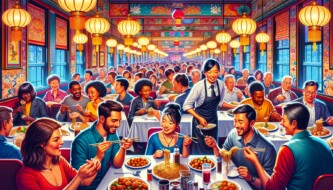Indo-Chinese cuisine, a fusion of Indian and Chinese food, is gaining popularity in the United States. The unique combination of flavors and spices has made dishes like cauliflower manchurian a favorite among Indian immigrants and Americans alike. The cuisine incorporates Chinese flavors with Indian ingredients such as soy sauce, vinegar, garlic, ginger, and plenty of chili. It has become a staple in Indian and Nepali restaurants, and many other eateries have added Indo-Chinese dishes to their menus to cater to the demand from Indian immigrants and the wider American population.
The origins of Indo-Chinese food can be traced back over 100 years to the city of Kolkata in India. Chinese migrants who arrived in Kolkata for work in the 19th century brought their food with them. The first Chinese eatery in Kolkata opened in the 1850s and catered mainly to the Chinese community. As Indians developed a taste for Chinese food, more spices were added to cater to Indian tastes, and Indo-Chinese cuisine began to emerge. By the 1960s, Chinese cuisine had become more accessible and affordable, reaching street-side stalls in the form of chowmein and chops.
The popularity of Indo-Chinese cuisine continued to grow as Chinese immigrants opened restaurants in countries like the US, UK, and Canada, attracting the Indian diaspora. Indo-Chinese food has become a nostalgic comfort food for many Indian immigrants, reminding them of their childhood and the flavors they grew up with. It has also found a following among adventurous Americans and Chinese customers who are curious to try something new.
While Indo-Chinese preparations are still absent from most Chinese restaurants in the US, they have become an essential part of Indian restaurant menus. Families with children, in particular, seek out Indo-Chinese options, as they offer a variety of dishes that appeal to different tastes. The popularity of Indo-Chinese cuisine has led to its inclusion in almost every Indian restaurant in the US, as it is not only delicious but also a profitable addition to their menus.
Overall, Indo-Chinese cuisine has made a splash in the US dining scene, appealing to both Indian immigrants and Americans. Its unique blend of flavors and spices has captured the taste buds of many, making it a popular choice in restaurants across the country.
Original news source: Indo-Chinese cuisine makes a splash in US dining (BBC)
Listen
Slow
Normal
Fast
Group or Classroom Activities
Warm-up Activities:
– News Summary
Instructions: Ask students to read the article and write a summary of the main points in their own words. Then, have them share their summaries with a partner and discuss any differences or similarities.
– Opinion Poll
Instructions: Divide the class into small groups and give each group a set of statements related to Indo-Chinese cuisine (e.g. “I enjoy trying new and unique flavors”, “I prefer traditional Indian food over fusion cuisine”). Have each group discuss the statements and indicate whether they agree or disagree. Afterward, have each group share their opinions with the rest of the class.
– Sketch It
Instructions: Provide each student with a piece of paper and a pen or pencil. Instruct them to read the article and choose a specific dish from Indo-Chinese cuisine. Without using any words, have them draw a sketch of the dish. Afterward, have the students share their sketches with a partner and try to guess the name of the dish based on the drawing.
– Vocabulary Pictionary
Instructions: Divide the class into pairs. Give each pair a list of vocabulary words related to Indo-Chinese cuisine (e.g. fusion, spices, flavors). One student from each pair takes turns choosing a word and drawing a picture to represent it, while the other student tries to guess the word. After a set amount of time, have the pairs switch roles.
– Pros and Cons
Instructions: Divide the class into two groups. One group will discuss the pros of Indo-Chinese cuisine (e.g. unique flavors, fusion of cultures), while the other group will discuss the cons (e.g. potential loss of traditional flavors, cultural appropriation). After a set amount of time, have each group present their arguments to the rest of the class. Encourage respectful discussion and debate.
Comprehension Questions:
1. What is Indo-Chinese cuisine and why is it gaining popularity in the United States?
2. How did Indo-Chinese cuisine originate in India?
3. Why did Indo-Chinese cuisine become more accessible and affordable in the 1960s?
4. How has Indo-Chinese cuisine become a nostalgic comfort food for Indian immigrants?
5. Who else besides Indian immigrants has shown interest in Indo-Chinese cuisine?
6. Why are Indo-Chinese preparations still absent from most Chinese restaurants in the US?
7. Why do families with children seek out Indo-Chinese options in Indian restaurants?
8. Why has Indo-Chinese cuisine become a profitable addition to Indian restaurant menus in the US?
Go to answers ⇩
Listen and Fill in the Gaps:
Indo-Chinese cuisine, a (1)______ of Indian and Chinese food, is gaining popularity in the United States. The (2)______ combination of flavors and spices has made dishes like cauliflower manchurian a favorite among Indian immigrants and Americans alike. The cuisine incorporates Chinese flavors with Indian ingredients such as soy sauce, (3)______, garlic, ginger, and plenty of chili. It has become a staple in Indian and Nepali restaurants, and many other eateries have added Indo-Chinese dishes to their (4)______ to cater to the demand from Indian immigrants and the wider American population.
The origins of Indo-Chinese food can be (5)______ back over 100 years to the city of Kolkata in India. Chinese (6)______ who arrived in Kolkata for work in the 19th century brought their food with them. The first Chinese eatery in Kolkata opened in the 1850s and (7)______ mainly to the Chinese community. As Indians developed a taste for Chinese food, more spices were added to cater to Indian tastes, and Indo-Chinese cuisine began to emerge. By the 1960s, Chinese cuisine had (8)______ more accessible and affordable, reaching street-side stalls in the form of chowmein and chops.
The popularity of Indo-(9)______ cuisine continued to grow as Chinese immigrants (10)______ restaurants in countries like the US, UK, and Canada, attracting the Indian (11)______. Indo-Chinese food has become a nostalgic comfort food for many Indian immigrants, reminding them of their childhood and the flavors they grew up with. It has also found a following among adventurous (12)______ and Chinese customers who are curious to try something new.
While Indo-Chinese preparations are still absent from most Chinese restaurants in the US, they have become an essential part of Indian restaurant menus. Families with children, in particular, seek out Indo-Chinese options, as they offer a variety of dishes that appeal to different (13)______. The popularity of Indo-Chinese cuisine has led to its inclusion in almost every Indian (14)______ in the US, as it is not only delicious but also a (15)______ addition to their menus.
Overall, Indo-Chinese cuisine has made a splash in the US (16)______ scene, appealing to both Indian immigrants and Americans. Its unique blend of flavors and spices has captured the taste buds of many, making it a popular choice in restaurants across the country.
Go to answers ⇩
Discussion Questions:
Students can ask a partner these questions, or discuss them as a group.
1. Have you ever tried Indo-Chinese cuisine? If so, what did you think of it?
2. What do you think makes Indo-Chinese cuisine unique compared to other types of fusion cuisine?
3. Why do you think Indo-Chinese cuisine has become so popular among Indian immigrants in the United States?
4. How do you think the addition of Indian spices and flavors to Chinese dishes affects the overall taste?
5. Do you think Indo-Chinese cuisine will continue to gain popularity in the future? Why or why not?
6. What other types of fusion cuisine have you tried? How does Indo-Chinese cuisine compare to them?
7. How important do you think it is for restaurants to cater to the tastes of different cultures and communities?
8. Have you ever had a nostalgic food experience? If so, what was it and why was it meaningful to you?
9. How do you think the popularity of Indo-Chinese cuisine reflects the diversity of the United States?
10. What do you think attracts adventurous eaters to try Indo-Chinese cuisine?
11. How do you think the inclusion of Indo-Chinese dishes on Indian restaurant menus affects their overall appeal?
12. Do you think it’s important for restaurants to adapt their menus to cater to families with children? Why or why not?
13. What do you think the future holds for fusion cuisine? Will it continue to evolve and gain popularity?
14. How do you think the popularity of Indo-Chinese cuisine in the US compares to its popularity in other countries like the UK and Canada?
15. Have you ever tried to recreate a dish from a different culture at home? How successful were you?
Individual Activities
Vocabulary Meanings:
Match each word to its meaning.
Words:
1. Indo-Chinese
2. cuisine
3. flavors
4. spices
5. dishes
6. restaurants
7. menus
8. popularity
Meanings:
(a) Ingredients used to enhance the taste of food
(b) The state of being liked, admired, or supported
(c) Plates or bowls of food prepared in a particular way
(d) The different tastes and aromas in food
(e) A fusion of Indian and Chinese food
(f) Places where food is prepared and served to customers
(g) Lists of food and drinks available for customers
(h) The style of cooking and preparing food
Go to answers ⇩
Multiple Choice Questions:
1. What is Indo-Chinese cuisine?
(a) Traditional Chinese cuisine
(b) Traditional Indian cuisine
(c) A fusion of Indian and Chinese food
(d) A fusion of Italian and Chinese food
2. What are some common ingredients in Indo-Chinese cuisine?
(a) Curry powder, cumin, turmeric, and coriander
(b) Olive oil, tomatoes, basil, and oregano
(c) Soy sauce, vinegar, garlic, ginger, and chili
(d) Rice, lentils, coconut milk, and curry leaves
3. Where did Indo-Chinese cuisine originate?
(a) Kolkata, India
(b) Beijing, China
(c) New York City, USA
(d) London, UK
4. How did Indo-Chinese cuisine evolve over time?
(a) It became more expensive and exclusive
(b) It became less popular and faded away
(c) It remained the same without any changes
(d) More spices were added to cater to Indian tastes
5. Who is the primary audience for Indo-Chinese cuisine in the US?
(a) Indian immigrants and Americans
(b) Chinese immigrants and Americans
(c) Europeans and Australians
(d) South Americans and Africans
6. Why has Indo-Chinese cuisine become popular in the US?
(a) It is cheap and affordable
(b) It is a traditional American dish
(c) It is a healthy and nutritious option
(d) It offers a unique blend of flavors and spices
7. Where can you find Indo-Chinese cuisine in the US?
(a) Chinese restaurants
(b) Indian restaurants
(c) Italian restaurants
(d) Mexican restaurants
8. Why do Indian restaurants in the US include Indo-Chinese dishes on their menus?
(a) It is a traditional Indian dish
(b) It is a profitable addition to their menus
(c) It is a popular choice among Americans
(d) It is a healthy and nutritious option
Go to answers ⇩
True or False Questions:
1. Indo-Chinese cuisine incorporates Chinese flavors with Indian ingredients such as soy sauce, vinegar, garlic, ginger, and chili.
2. The origins of Indo-Chinese food cannot be traced back over 100 years to the city of Kolkata in India.
3. Indo-Chinese cuisine has made a splash in the US dining scene, appealing to both Indian immigrants and Americans alike.
4. Indo-Chinese cuisine is not a fusion of Indian and Chinese food that is gaining popularity in the United States.
5. Dishes like cauliflower manchurian have become a favorite among both Indian immigrants and Americans.
6. Chinese migrants who arrived in Kolkata in the 19th century did not bring their food with them, leading to the emergence of Indo-Chinese cuisine.
7. Indo-Chinese food has not become a nostalgic comfort food for many Indian immigrants, reminding them of their childhood and the flavors they grew up with.
8. Indo-Chinese cuisine has become a staple in Indian and Nepali restaurants, and many other eateries have added Indo-Chinese dishes to their menus.
Go to answers ⇩
Write a Summary:
Write a summary of this news article in two sentences.
Check your writing now with the best free AI for English writing!
Writing Questions:
Answer the following questions. Write as much as you can for each answer.
Check your answers with our free English writing assistant!
1. What are the key ingredients used in Indo-Chinese cuisine?
2. Where did Indo-Chinese cuisine originate?
3. How has Indo-Chinese cuisine gained popularity in countries like the US, UK, and Canada?
4. Why has Indo-Chinese cuisine become a nostalgic comfort food for many Indian immigrants?
5. Why have Indo-Chinese dishes become a staple in Indian restaurant menus in the US?
Answers
Comprehension Question Answers:
1. Indo-Chinese cuisine is a fusion of Indian and Chinese food, incorporating Chinese flavors with Indian ingredients. It is gaining popularity in the United States due to its unique combination of flavors and spices, which has made it a favorite among Indian immigrants and Americans alike.
2. Indo-Chinese cuisine originated in the city of Kolkata in India over 100 years ago. Chinese migrants who arrived in Kolkata for work in the 19th century brought their food with them. As Indians developed a taste for Chinese food, more spices were added to cater to Indian tastes, giving rise to Indo-Chinese cuisine.
3. Indo-Chinese cuisine became more accessible and affordable in the 1960s as it reached street-side stalls in the form of dishes like chowmein and chops. This made it more widely available to the general public.
4. Indo-Chinese cuisine has become a nostalgic comfort food for many Indian immigrants because it reminds them of their childhood and the flavors they grew up with. It serves as a connection to their cultural heritage.
5. Besides Indian immigrants, Indo-Chinese cuisine has also attracted interest from adventurous Americans and Chinese customers who are curious to try something new.
6. Indo-Chinese preparations are still absent from most Chinese restaurants in the US because they are primarily focused on serving traditional Chinese dishes. Indo-Chinese cuisine is more commonly found in Indian and Nepali restaurants.
7. Families with children seek out Indo-Chinese options in Indian restaurants because they offer a variety of dishes that appeal to different tastes. This makes it easier for families to find something that everyone will enjoy.
8. Indo-Chinese cuisine has become a profitable addition to Indian restaurant menus in the US because of its popularity among both Indian immigrants and Americans. By offering Indo-Chinese dishes, restaurants can cater to a wider customer base and increase their revenue.
Go back to questions ⇧
Listen and Fill in the Gaps Answers:
(1) fusion
(2) unique
(3) vinegar
(4) menus
(5) traced
(6) migrants
(7) catered
(8) become
(9) Chinese
(10) opened
(11) diaspora
(12) Americans
(13) tastes
(14) restaurant
(15) profitable
(16) dining
Go back to questions ⇧
Vocabulary Meanings Answers:
1. Indo-Chinese
Answer: (e) A fusion of Indian and Chinese food
2. cuisine
Answer: (h) The style of cooking and preparing food
3. flavors
Answer: (d) The different tastes and aromas in food
4. spices
Answer: (a) Ingredients used to enhance the taste of food
5. dishes
Answer: (c) Plates or bowls of food prepared in a particular way
6. restaurants
Answer: (f) Places where food is prepared and served to customers
7. menus
Answer: (g) Lists of food and drinks available for customers
8. popularity
Answer: (b) The state of being liked, admired, or supported
Go back to questions ⇧
Multiple Choice Answers:
1. What is Indo-Chinese cuisine?
Answer: (c) A fusion of Indian and Chinese food
2. What are some common ingredients in Indo-Chinese cuisine?
Answer: (c) Soy sauce, vinegar, garlic, ginger, and chili
3. Where did Indo-Chinese cuisine originate?
Answer: (a) Kolkata, India
4. How did Indo-Chinese cuisine evolve over time?
Answer: (d) More spices were added to cater to Indian tastes
5. Who is the primary audience for Indo-Chinese cuisine in the US?
Answer: (a) Indian immigrants and Americans
6. Why has Indo-Chinese cuisine become popular in the US?
Answer: (d) It offers a unique blend of flavors and spices
7. Where can you find Indo-Chinese cuisine in the US?
Answer: (b) Indian restaurants
8. Why do Indian restaurants in the US include Indo-Chinese dishes on their menus?
Answer: (b) It is a profitable addition to their menus
Go back to questions ⇧
True or False Answers:
1. Indo-Chinese cuisine incorporates Chinese flavors with Indian ingredients such as soy sauce, vinegar, garlic, ginger, and chili. (Answer: True)
2. The origins of Indo-Chinese food cannot be traced back over 100 years to the city of Kolkata in India. (Answer: False)
3. Indo-Chinese cuisine has made a splash in the US dining scene, appealing to both Indian immigrants and Americans alike. (Answer: True)
4. Indo-Chinese cuisine is not a fusion of Indian and Chinese food that is gaining popularity in the United States. (Answer: False)
5. Dishes like cauliflower manchurian have become a favorite among both Indian immigrants and Americans. (Answer: True)
6. Chinese migrants who arrived in Kolkata in the 19th century did not bring their food with them, leading to the emergence of Indo-Chinese cuisine. (Answer: False)
7. Indo-Chinese food has not become a nostalgic comfort food for many Indian immigrants, reminding them of their childhood and the flavors they grew up with. (Answer: False)
8. Indo-Chinese cuisine has become a staple in Indian and Nepali restaurants, and many other eateries have added Indo-Chinese dishes to their menus. (Answer: True)
Go back to questions ⇧













